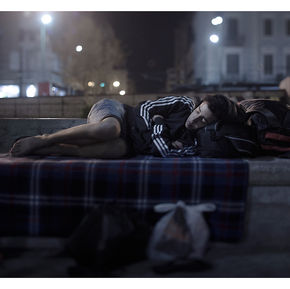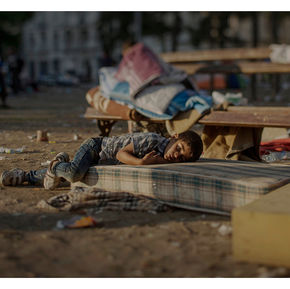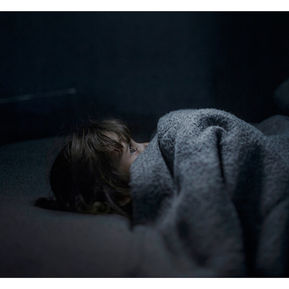FOTOTECA SIRACUSANA
PHOTOGALLERY - FOTOGRAFIA VINTAGE - BIBLIOTECA TEMATICA - CAMERA OSCURA B&W - DIDATTICA
SCRIPTPHOTOGRAPHY
Magnus WENNMAN (Svezia)

MAGNUS WENNMAN
La prima vittima di ogni guerra è la verità. Dopo, appena il tempo d’un battito di ciglia, tocca ai bambini. Siria. La sanguinosa guerra civile che si protrae da sette lunghi anni ha causato – secondo l'Osservatorio dei diritti umani in Siria – oltre 500 000 vittime. Tra i civili la barbarie ha mietuto circa 100 000 civili, di cui un terzo sono bambini o minori. Numeri impressionanti. Si è detto che se per ogni attentato in Europa ci siamo raccolti in un silenzioso cordoglio con la Siria dovremmo starcene in silenzio per l’eternità. La Siria è un paese fantasma. Un re che non ama i suoi sudditi li sta uccidendo, mentre costringe metà della popolazione a sfollare, a riparare all’estero. Il fotografo Magnus Wennman ha incontrato i rifugiati siriani negli innumerevoli campi e sulla loro strada attraverso l’Europa, consegnandoci un lavoro che costringe tutti noi alla commozione più profonda. Wennman ha fotografato i bambini, come si è detto, vittime innocenti di un’insensatezza senza pari. Li ha fotografati per consegnarci “Where The Children Sleep”, un lavoro asciutto, lontanissimo dalla retorica in cui si adagia la narrazione della guerra e che restituisce in pieno il senso della fotografia etica. In ogni immagine, infatti, è assente ogni compiacimento che in noi ha l’effetto di procurare sdegno: non c’è nulla di sanguinolento, ma c’è qualcosa di peggio. Ci sono gli effetti del velenoso regalo che una guerra conduce ai bambini e che cogliamo in ogni singolo sguardo, nei loro silenzi: la cancellazione di un destino. I bambini, gli adolescenti che vediamo ci stordiscono, ci lasciano muti davanti alle nostre responsabilità. Ci chiedono cosa stiamo facendo per loro e le risposte non sono mai all’altezza delle loro silenziose richieste. Poi, come conquistati da un’improvvisa e amara consapevolezza, quegli occhi ci attraversano per posarsi su un punto lontano, invisibile, che noi neppure conosciamo. Hanno occhi i bambini siriani assai diversi da quelli dei nostri. Nei loro manca la luce, hanno visto giorni che mai nessun bambino dovrebbe vedere: hanno visto la morte, i boati dei bombardamenti, odorato la polvere acre delle macerie, ascoltato il ruggito della cupa violenza e conosciuto il rosso colore del sangue sgorgare dai corpi dei cari. Vittime. Per sempre vittime. “Where The Children Sleep” è il racconto di un orrore irreparabile: l’uccisione del diritto di ogni bambino a vivere come ogni bambino merita. Non hanno più casa, non hanno più giochi, non hanno più un letto, non sognano più. Hanno solo i loro pochi anni e un destino che i “grandi” hanno voluto dissipare gettandolo lontanissimo. Nelle fotografie di “Where The Children Sleep” risalta la notte. Una notte molto lontana da ogni metafora, buia come la loro improvvisa condizione. E i letti: d’ospedale, di qualche campo, persino di fortuna tra le strade di una città che potrebbe essere la nostra. Qui quegli sfortunati bambini colti da Wennman sono soli, indifesi, bisognosi di un aiuto che sappia lenire le sofferenze di ricordi ancor più giovani della loro età, quando basterebbe il calore di un abbraccio per restituire speranza e ravvivare i loro occhi della serenità che meritano. Che Dio dimostri una particolare preferenza per questi bambini. Lo meritano, come meritano che il ricco Occidente trovi una soluzione a una tragedia che racchiude la sua scelleratezza nell’immagine disperata di una madre con in braccia il proprio figlio. Quest’immagine, una “pietà laica”, ci scuote dalle fondamenta e della quale, in quanto genitori, condividiamo fino in fondo il senso di una disperazione, buia, come i sonni senza sogni dei bambini; un’immagine che da Steichein a Natchwey passando per Aranda sino a Wennman, ci suggerisce che uno sconfinato amore è l’antidoto a ogni guerra. Guardatela mentre regge il figlio stretto a sé: è disperata, mai nessuno potrà consolarla. Noi non vediamo il suo volto e dunque non vediamo i suoi occhi ma li immaginiamo umidi di lacrime, chiusi alla visione di un mondo che ne ha condizionato l’esistenza: ha un velo davanti al volto e le mani al viso, si protegge. Lasciamola al suo silenzioso e dignitoso dolore, alla paura e all’impotenza di non potere offrire al figlio un futuro diverso dal presente. Rispettiamola, anche quando la nostre sensibilità ci accosterà al suo dramma, saremo sempre all’ombra di un dolore a noi sconosciuto, quella di una guerra finita nel silenziatore della realpolitik della nostra indifferenza.
Giuseppe Cicozzetti
da “Where The Children Sleep”
foto Magnus Wennmann
The first victim of every war is the truth. After, just the time of a blink of an eye, it's up to the children. Syria. The bloody civil war that has been going on for seven long years has caused - according to the Human Rights Observatory in Syria - over 500,000 victims.
Among the civilians, war has claimed about 100,000 civilians, of which one third are children or minors. Impressive numbers. It has been said that if we have gathered in silent condolences with Syria for every attack in Europe, we should be silent for eternity. Syria is a ghost country. A king who does’t love his people is killing them, while forcing half the population to displace, to repair abroad.
The photographer Magnus Wennman met the Syrian refugees in countless camps and on their way through Europe, giving us a job that forces us all to the deepest emotion. Wennman has photographed the children, as we have said, innocent victims of an unbearable nonsense. He photographed them to give us "Where The Children Sleep", a harsh work, far away from the rhetoric in which the narration of the war lies and which fully restores the sense of ethical photography.
In fact, in every image there is no complacency that has the effect of causing indignation: there is nothing bloody, but there is something worse. There are the effects of the poisonous gift that a war leads to children and that we catch in every single glance, in their silences: the cancellation of a destiny.
The children, the teenagers we see, stun us, leave us silent before our responsibilities. They ask us what we are doing for them and the answers are never up to their silent requests. Then, as if conquered by a sudden and bitter awareness, those eyes cross us to settle on a distant, invisible point, which we do not even know. Syrian children have very different eyes from those of our own.
In their eyes light is missing, they have seen days that no child should see: they have seen death, the roars of the bombings, they smell the acrid dust of the rubble, listened to the roar of dark violence and known the red color of the blood gushing from the bodies of relatives. Victims. Forever victims. “Where The Children Sleep" is the story of an irreparable horror: the killing of the right of every child to live as every child deserves. They no longer have a home, no longer have games, no longer have a bed, no longer dream. They have only their few years and a destiny that the "big" wanted to dispel by throwing it far away.
Night stands in the photographs of "Where The Children Sleep." A night very far from any metaphor, as dark as their sudden condition, and the beds: from the hospital, from some field, even luckily through the streets of a city that Here, those unfortunate children captured by Wennman are alone, helpless, in need of help that can relieve the suffering of memories even younger than their age, when the warmth of a hug would enough to restore hope and revive their eyes of the serenity they deserve.
May God demonstrate a particular preference for these children. They deserve it, as they deserve that the rich West find a solution to a tragedy that contains his villain in the desperate image of a mother holding her own son. This image, a "secular piety", shakes us from the foundations and from which, as parents, we fully share the sense of despair, dark, like dreams without dreams of children; an image that from Steichein to Natchwey through Aranda to Wennman, suggests that a boundless love is the antidote to every war.
Look at her while she holds her son close to her: she is desperate, no one will ever be able to console her. We don’t see his face and therefore we do not see his eyes but we imagine them wet with tears, closed to the vision of a world that has conditioned his existence: she has a veil in front of his face and her hands are protected. Let’s leave to her silent and dignified grief, to the fear and impotence of not being able to offer the child a future different from the present. Respect it, even when our sensibilities will approach us to its drama, we will always be in the shadow of a pain unknown to us, that of a war ended in the silencer of the realpolitik of our indifference.
Giuseppe Cicozzetti
from “Where The Children Sleep”
ph. Magnus Wennman















